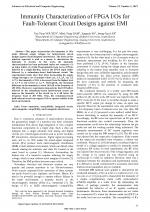| 2/2019 - 5 |
Immunity Characterization of FPGA I/Os for Fault-Tolerant Circuit Designs against EMINGUYEN, V. T. |
| Extra paper information in |
| Click to see author's profile in |
| Download PDF |
Author keywords
immunity, susceptibility, integrated circuit, electromagnetic compatibility, electromagnetic interference
References keywords
circuits(10), integrated(9), power(8), immunity(7), electromagnetic(7), temc(6), susceptibility(6), electro(6), compat(6), modeling(4)
Blue keywords are present in both the references section and the paper title.
About this article
Date of Publication: 2019-05-31
Volume 19, Issue 2, Year 2019, On page(s): 37 - 44
ISSN: 1582-7445, e-ISSN: 1844-7600
Digital Object Identifier: 10.4316/AECE.2019.02005
Web of Science Accession Number: 000475806300005
SCOPUS ID: 85066298408
Abstract
This paper characterizes the immunity of I/Os under different supply voltages for fault-tolerant circuit designs against electromagnetic interference. The direct power injection approach is used as a means to characterize the immunity of circuits. In this work, the immunity characterization has been performed under two scenarios: (1) an input buffer of a Field Programmable Gate Array (FPGA) followed by a single flip-flop, and (2) the FPGA input buffer followed by a redundancy-based fault-tolerant circuit. The experimental results show that when downscaling the supply voltage through a set of nominal values (i.e., 3.3, 2.5, 1.8, 1.5, 1.2 V), the immunity of I/Os is decreased from the highest level at 3.3 V to the lowest at 1.2 V. Particularly, the maximum difference in the immunity is about 16.8 dB at the frequency of 600 MHz. Moreover, experiments demonstrate that I/O buffers followed by the redundancy-based fault-tolerant circuit can improve the immunity of the circuit up to 4 dB below the frequency band of 400 MHz. Thus, the redundancy-based fault-tolerant circuit can support I/Os to operate reliably in the harsh environment. |
| References | | | Cited By |
Web of Science® Times Cited: 3 [View]
View record in Web of Science® [View]
View Related Records® [View]
Updated today
SCOPUS® Times Cited: 4
View record in SCOPUS® [Free preview]
View citations in SCOPUS® [Free preview]
[1] Hybrid Pipeline Hardware Architecture Based on Error Detection and Correction for AES, Algredo-Badillo, Ignacio, Ramírez-Gutiérrez, Kelsey A., Morales-Rosales, Luis Alberto, Pacheco Bautista, Daniel, Feregrino-Uribe, Claudia, Sensors, ISSN 1424-8220, Issue 16, Volume 21, 2021.
Digital Object Identifier: 10.3390/s21165655 [CrossRef]
[2] A SHA-256 Hybrid-Redundancy Hardware Architecture for Detecting and Correcting Errors, Algredo-Badillo, Ignacio, Morales-Sandoval, Miguel, Medina-Santiago, Alejandro, Hernández-Gracidas, Carlos Arturo, Lobato-Baez, Mariana, Morales-Rosales, Luis Alberto, Sensors, ISSN 1424-8220, Issue 13, Volume 22, 2022.
Digital Object Identifier: 10.3390/s22135028 [CrossRef]
[3] Hysteresis Based Quasi Fixed Frequency Current Control of Single Phase Full Bridge Grid Integrated Voltage Source Inverter, Syamala, Lakshmi, Sankar, Deepa, Makkar, Suhara Ekkarakkudy, Jos, Bos Mathew, Kallarackal, Mathew, Energies, ISSN 1996-1073, Issue 21, Volume 15, 2022.
Digital Object Identifier: 10.3390/en15218112 [CrossRef]
[4] Empirical estimation of the frequency’s domain of susceptibility of electronic devices by the method of the striking electromagnetic influence, Ostashev, V. E., Ulyanov, A. V., Radiotehnika i èlektronika, ISSN 0033-8494, Issue 5, Volume 69, 2024.
Digital Object Identifier: 10.31857/S0033849424050115 [CrossRef]
Disclaimer: All information displayed above was retrieved by using remote connections to respective databases. For the best user experience, we update all data by using background processes, and use caches in order to reduce the load on the servers we retrieve the information from. As we have no control on the availability of the database servers and sometimes the Internet connectivity may be affected, we do not guarantee the information is correct or complete. For the most accurate data, please always consult the database sites directly. Some external links require authentication or an institutional subscription.
Web of Science® is a registered trademark of Clarivate Analytics, Scopus® is a registered trademark of Elsevier B.V., other product names, company names, brand names, trademarks and logos are the property of their respective owners.
Faculty of Electrical Engineering and Computer Science
Stefan cel Mare University of Suceava, Romania
All rights reserved: Advances in Electrical and Computer Engineering is a registered trademark of the Stefan cel Mare University of Suceava. No part of this publication may be reproduced, stored in a retrieval system, photocopied, recorded or archived, without the written permission from the Editor. When authors submit their papers for publication, they agree that the copyright for their article be transferred to the Faculty of Electrical Engineering and Computer Science, Stefan cel Mare University of Suceava, Romania, if and only if the articles are accepted for publication. The copyright covers the exclusive rights to reproduce and distribute the article, including reprints and translations.
Permission for other use: The copyright owner's consent does not extend to copying for general distribution, for promotion, for creating new works, or for resale. Specific written permission must be obtained from the Editor for such copying. Direct linking to files hosted on this website is strictly prohibited.
Disclaimer: Whilst every effort is made by the publishers and editorial board to see that no inaccurate or misleading data, opinions or statements appear in this journal, they wish to make it clear that all information and opinions formulated in the articles, as well as linguistic accuracy, are the sole responsibility of the author.



